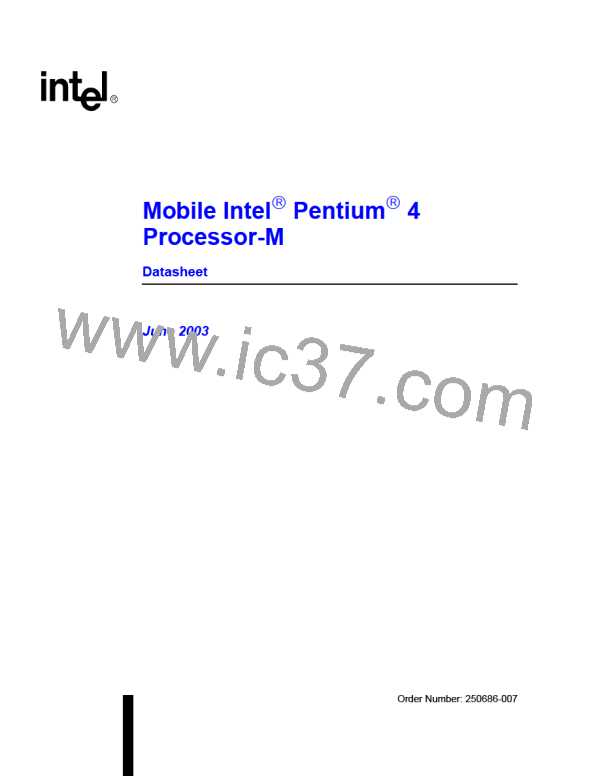Thermal Specifications and Design Considerations
Where IS = saturation current, q = electronic charge, VD = voltage across the diode, k = Boltzmann Constant,
and T = absolute temperature (Kelvin).
5. The series resistance, RT, is provided to allow for a more accurate measurement of the diode junction
temperature. RT as defined includes the pins of the processor but does not include any socket resistance or
board trace resistance between the socket and the external remote diode thermal sensor. RT can be used by
remote diode thermal sensors with automatic series resistance cancellation to calibrate out this error term.
Another application is that a temperature offset can be manually calculated and programmed into an offset
register in the remote diode thermal sensors as exemplified by the equation:
Terror = [RT*(N-1)*IFWmin]/[(nk/q)*ln N]
Where Terror = sensor temperature error, N = sensor current ration, k = Boltzmann Constant, q = electronic
charge.
6.1.2
Thermal Monitor
The thermal monitor feature found in the Mobile Intel Pentium 4 Processor-M allows system
designers to design lower cost thermal solutions without compromising system integrity or
reliability. By using a factory-tuned, precision on-die thermal sensor, and a fast acting thermal
control circuit (TCC), the processor, without the aid of any additional software or hardware, can
keep the processor’s die temperature within factory specifications under nearly all conditions. The
thermal monitor thus allows the processor and system thermal solutions to be designed much closer
to the power envelopes of real applications, instead of being designed to the much higher
maximum processor power envelopes.
The thermal monitor controls the processor temperature by modulating (starting and stopping) the
processor core clocks. The processor clocks are modulated when the thermal control circuit (TCC)
is activated. The thermal monitor uses two modes to activate the TCC: Automatic mode and On-
Demand mode. Automatic mode is required for the processor to operate within specifications
and must first be enabled via BIOS. Once automatic mode is enabled, the TCC will activate only
when the internal die temperature is very near the temperature limits of the processor. When TCC
is enabled, and a high temperature situation exists (i.e. TCC is active), the clocks will be modulated
by alternately turning the clocks off and on at a duty cycle specific to the processor (typically
30-50%). An under-designed thermal solution that is not able to prevent excessive activation of the
TCC in the anticipated ambient environment may cause a noticeable performance loss. Cycle times
are processor speed dependent and will decrease linearly as processor core frequencies increase.
Once the temperature has returned to a non-critical level, modulation ceases and TCC goes
inactive. A small amount of hysteresis has been included to prevent rapid active/inactive transitions
of the TCC when the processor temperature is near the trip point. Processor performance will be
decreased by approximately the same amount as the duty cycle when the TCC is active, however,
with a properly designed and characterized thermal solution, the TCC will only be activated briefly
when running the most power intensive applications in a high ambient temperature environment.
For automatic mode, the duty cycle is factory configured and cannot be modified. Also, automatic
mode does not require any additional hardware, software drivers or interrupt handling routines.
The TCC may also be activated via On-Demand mode. If bit 4 of the ACPI Thermal Monitor
Control register is written to a 1 the TCC will be activated immediately, independent of the
processor temperature. When using On-Demand mode to activate the TCC, the duty cycle of the
clock modulation is programmable via bits 3:1 of the same ACPI Thermal Monitor Control
register. In automatic mode, the duty cycle is fixed, however in On-Demand mode, the duty cycle
can be programmed from 12.5% on/ 87.5% off, to 87.5% on/12.5% off in 12.5% increments. On-
Demand mode may be used at the same time Automatic mode is enabled, however, if the system
tries to enable the TCC via On-Demand mode at the same time automatic mode is enabled AND a
high temperature condition exists, the duty cycle of the automatic mode will override the duty
cycle selected by the On-Demand mode.
Mobile Intel Pentium 4 Processor-M Datasheet
91

 INTEL [ INTEL ]
INTEL [ INTEL ]